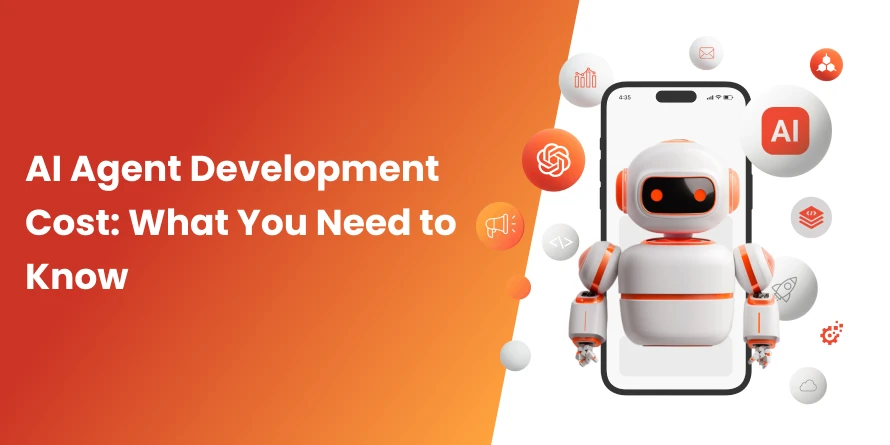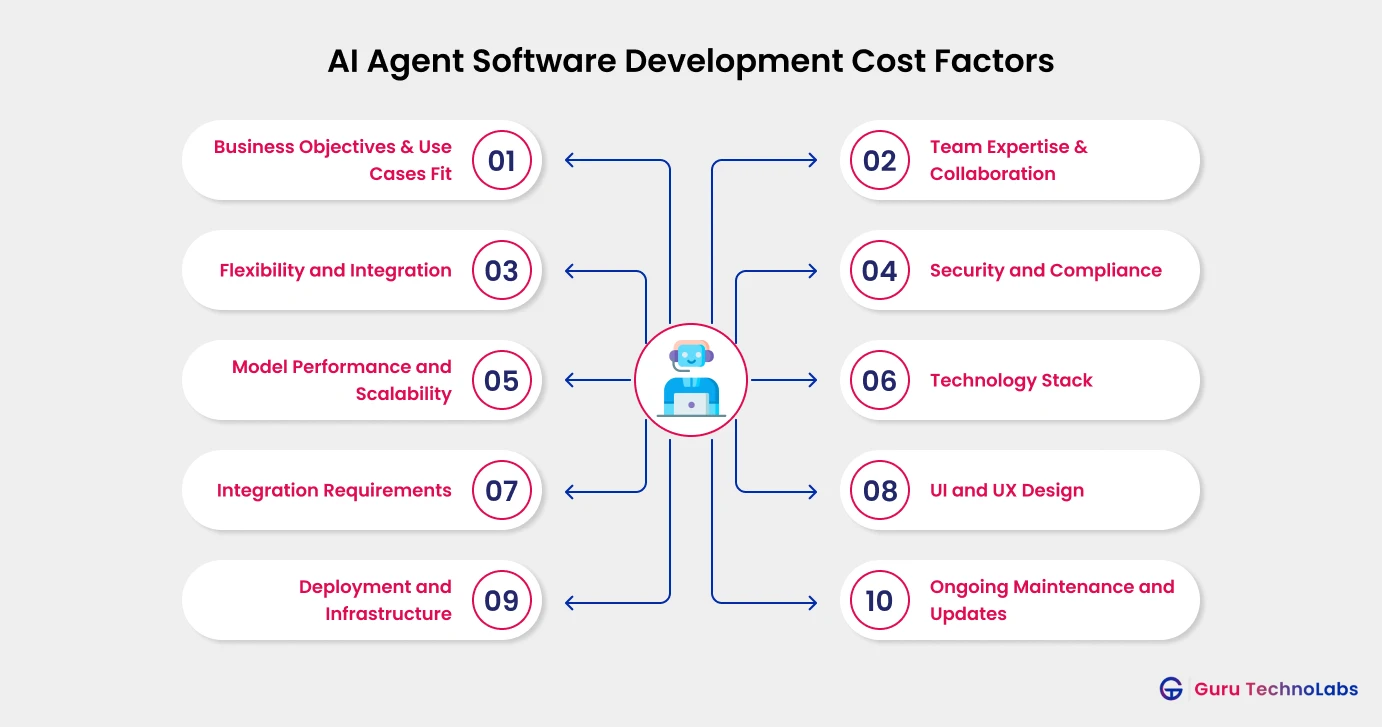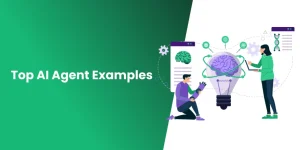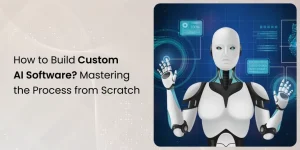AI Agent Development Cost: What You Need to Know

Many teams underestimate the costs involved when building AI agents, not because of technical barriers, but because of unclear planning and inaccurate cost estimates. Creating an AI agent is fundamentally different from traditional software projects, and several factors can quickly drive up costs if not properly addressed:
- High-performance infrastructure is essential for managing latency, user concurrency, and real-time processing demands.
- Integrating AI tools, managing workflows, and creating fallback systems requires extra planning and resources.
- AI agents need constant tuning, monitoring, and retaining to stay effective after launch.
Your development costs can fluctuate based on several decisions, such as:
- Are you building an agent from the ground up or leveraging an AI platform?
- Will you handle the development internally or hire dedicated developers to perform certain tasks?
These choices will significantly impact your budget, both upfront and long-term.
Let’s explore each approach, identify the biggest cost gaps, and understand how your choices will influence time-to-value. We’ll also highlight key budget considerations before you commit.
What is the Exact Cost to Build an AI Agent?
On average, building an AI agent can start at under $10,000 for simple chatbot-style agents and can exceed $300,000 for advanced enterprise-level solutions. The total cost largely depends on the complexity, features, and specific requirements of the AI agent.
Based on 2025 industry standards, here’s a general cost range:
- Basic AI Agent (e.g., rule-based chatbot): $10,000 – $25,000
- Mid-Level Agent (e.g., NLP with API integration): $30,000 – $100,000
- Advanced Agent (e.g., custom-trained, real-time, multimodal): $120,000 – $300,000+
These figures represent the complete development lifecycle, from planning and data preparation to deployment and ongoing maintenance.
Next, let’s break down the key factors that influence these costs and dive into a detailed cost analysis.
Factors Influencing the Cost of AI Agent Development
Every successful AI agent’s project starts with understanding what truly drives its development. Reviewing real-world AI agent examples can offer clarity on functionality, complexity, and the level of investment required.
However, Building an AI agent isn’t just about clever code – it’s about aligning technology with real human needs, business goals, and the ever-changing landscape of digital innovation.
Here are the key factors that shape AI agent software development today:

1. Business Objectives & Use Cases Fit
- The foundation of any AI agent project is a clear understanding of what problems you’re solving and why.
- Defining specific goals – like automating support, boosting sales, or personalizing user experiences, ensures your agent is purpose-built and delivers real value.
2. Team Expertise & Collaboration
AI agent development is a team sport. You need the right mix of AI engineers, software developers, and UX experts. If your in-house skills are limited, consider an external consultant or a dedicated development team to fill the gaps and accelerate delivery.
3. Flexibility and Integration
- Your agent should easily adapt to new challenges and work seamlessly with existing tools and platforms.
- Flexible frameworks and strong interoperability are crucial for building agents that can evolve and connect with third-party services as your business grows.
4. Security and Compliance
Protecting sensitive data and ensuring compliance with regulations like HIPAA or GDPR isn’t optional – it’s essential. Strong security measures and transparent data handling build trust and safeguard your organization and users.
5. Model Performance and Scalability
Better, faster, and more efficient AI models mean your agent can handle complex tasks, scale to more users, and deliver results in real time. Advances like larger context windows and improved reasoning are making agents more capable than ever.
6. Technology Stack
The thoughtful selection of programming languages, AI frameworks (e.g., TensorFlow, PyTorch), cloud platforms (e.g., AWS, Microsoft Azure, Google Cloud), and other modern technologies, collectively known as an AI tech stack can directly influence the overall cost.
7. Integration Requirements
Integrating AI agents with existing systems, such as CRMs, ERPs, or legacy databases, can significantly impact development costs.
For instance, connecting an AI agent to Salesforce or SAP may cost between $5,000 and $15,000 for modern APIs, but legacy systems could escalate this to $20,000 -$80,000 due to the need for custom adapters and data standardization.
Each additional integration adds complexity, requiring secure API connections, real-time data flows, and thorough testing.
8. UI and UX Design
The user interface (UI) and user experience (UX) design play a crucial role in making AI agents intuitive, user-friendly, and engaging. A well-designed interface not only enhances usability but also increases user adoption and satisfaction.
9. Deployment and Infrastructure
The choice of deployment – on-premise, cloud-based, or hybrid – affects both initial and ongoing costs. Cloud deployment is cost-effective, ranging from $20,000 to $40,000, while on-premise solutions can exceed $50,000 due to hardware and IT infrastructure requirements.
Additionally, the scalability and security needs of the AI agent influence the infrastructure decisions and associated costs.
10. Ongoing Maintenance and Updates
AI agents require continuous monitoring and updates to maintain performance and adapt to new data. Annual maintenance costs typically range from 15% to 25% of the initial development cost. This includes bug fixes, AI model re-training, and scalability enhancements. Regular updates ensure that the AI agent remains effective and secure over time.
By understanding the above factors, businesses can better estimate the cost of AI agent development and make smart decisions that align with their goals and budget.
AI Agent Development Stages and Their Cost Impact
Understanding the cost structure of AI agent development is key to effective budgeting and resource allocation. Below is a detailed breakdown of the development process, highlighting each phase’s cost impact and purpose.
Planning and Research – 10% of Total Cost
- This phase involves defining use cases, outlining objectives, gathering initial datasets, and choosing appropriate AI/ML approaches.
- Strategic planning here prevents downstream rework and ensures technical alignment with business goals.
Model Development and Training – 30% of Total Cost
- Includes data preprocessing, feature engineering, training of models (using custom or pre-trained architectures), and iterative experimentation.
- Compute costs, GPU time, and data labeling dominate this phase, especially for deep learning agents.
Frontend and Backend Engineering – 20% of Total Cost
- Involves building user interfaces, agent interaction layers (chat, voice, APIs), and backend logic to handle model inference.
- Scalability and security are addressed here to support real-time performance and user interaction.
Integration & Testing – 15% of Total Cost
- Covers the connection between AI models and business systems (e.g., CRMs, databases), along with automated and manual testing.
- Performance tuning, edge-case handling, and functional validation ensure reliability in production.
Pricing Models For AI Agent Development: Choose What Fits Best
Choosing the right pricing model for AI agent development is essential for aligning budget, project scope, and delivery expectations. The ideal model depends on factors like project complexity, timeline flexibility, and your long-term engagement strategy.
Below are the most common pricing models and who they work best for.

Fixed Price Model
A predetermined cost is agreed upon for the entire project, based on detailed requirements defined upfront.
- Best for: Well-scoped, low-variability projects like building a proof-of-concept (POC) or a basic chatbot with clear deliverables.
- Pricing Insights: Fixed-price contracts reduce budget risk but offer limited flexibility if new features or scope changes arise mid-development.
Time and Material Model
You pay for the actual hours worked and resources used, typically on a weekly or monthly basis.
- Best for: Evolving or complex AI agents, where requirements are expected to change, such as R&D – driven projects or adaptive learning systems.
- Pricing Insights: Offers flexibility and transparency, but may lead to higher or unpredictable costs without tight project management.
Subscription-based Model
A recurring fee (monthly or annually) that covers development, deployment, and continued improvements.
- Best for: Businesses looking for long-term AI partnerships, such as SaaS integrations or managed AI services that require frequent updates.
- Pricing Insight: Predictable cost structure, ideal for businesses seeking ongoing enhancements without large upfront investments.
Revenue Sharing Model
Development cost is subsidized or deferred in exchange for a share of the revenue generated by the AI agent’s use.
- Best for: Startups or partners with innovative ideas but limited capital, where both parties take on shared risk and reward.
- Pricing Insight: Lower initial cost, but long-term payouts may surpass traditional models depending on the agent’s success.
How to Reduce AI Agent Development Cost?
Developing AI agents can quickly become expensive due to complex data requirements, model training, and infrastructure demand. However, applying strategic techniques can significantly lower costs without sacrificing performance.
Adopt Lightweight Architectures
Use efficient models like DistilBERT or MobileNet that require less computational power, cutting both training time and infrastructure cost.
Implement Transfer Learning
Fine-tune pre-trained models instead of training from scratch to save on compute resources and data labeling efforts.
Use Synthetic Data for Training
Leverage synthetic data generation tools to reduce the dependency on expensive, manually labeled datasets.
Automate Hyperparameter Tuning
Deploy AutoML or Bayesian optimization tools to eliminate manual tuning and reduce iterative training expenses.
Leverage Serverless and Spot Instances
Run training and inference on serverless platforms or spot instances to scale cost-effectively and pay only for actual usage.
Optimize Code and Frameworks
Choose optimized libraries (e.g., TensorRT, ONNX) and parallelized code to make better use of available hardware and reduce runtime costs.
Deploy on Edge When Possible
Edge deployment avoids cloud inference costs and lowers latency, especially for real-time agents with consistent workloads.
Conclusion: Plan Your AI Agent Development Journey in 2025
Understanding the AI agent development cost is important for businesses looking to leverage the power of artificial intelligence. By evaluating the factors listed above, accurately choosing the costing model, and employing best practices, businesses can ensure the successful AI agent development that drives meaningful business outcomes.
Guru TechnoLabs is recognized as an experienced AI development company, wherein the skilled team of professionals ensures that the projects are handled efficiently. Besides, we also offer robust post-development support to ensure that AI applications remain relevant and functional.
If you want more information on AI agent development cost, contact us and share your views, and we’ll help you build the best product while staying within budget.
Frequently Asked Questions
Costs can range from $10,000 for basic rule-based agents to over $300,000 for advanced custom-trained models with NLP and reinforcement learning, depending on complexity, data needs, and infrastructure.
Use spot instances, auto-scaling, and cloud credits, optimize training pipelines with efficient data batching, and leverage open-source tools like Hugging Face or ONNX to streamline compute usage.
Yes, leveraging pre-trained models like GPT, BERT, or Stable Diffusion cuts down training time, compute requirements, and data collection costs, offering a high-performance baseline at a fraction of the price.
Absolutely - these platforms abstract complex AI workflows, reducing the need for a large engineering team and enabling faster prototyping with minimal upfront investment.


















